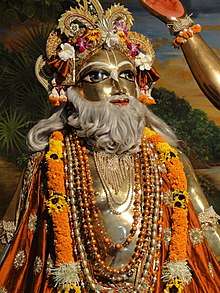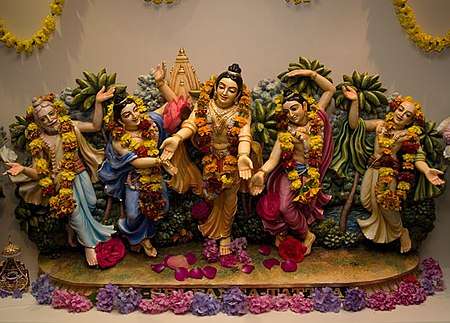Advaita Acharya
Advaita Ācārya (Bengali: অদ্বৈত আচার্য) (1434–1559), born Kamalaksha Mishra[1]was said to be a devotee of Vishnu in the Gaudiya Vaishnava sampradaya, companion of the founder of the Gaudiya Vaishnava sect, Chaitanya Mahaprabhu, and guru of Haridasa Thakur.[2][3] He was born at Navagrama-Laur village in the present-day Sunamganj District of Bangladesh in 1434, some fifty years before Chaitanya, and spent most of his adult life in the town of Shantipur in Nadia with his wife and family. Advaita Acharya had six sons, Acyutananda Das (A prominent saint like his father & discipline of mahaprabhu), Krisna Mishra, Gopala Das (His leniage became the zamindar of Krishna Chandra and lived in 'Tabga Village, Chatkhil-Noakhali), Balarama Das, Swarupa Das, and Jagadisa Mishra.
Śrī Advaita Ācārya | |
|---|---|
 Murti of Śrī Advaita Ācārya, ISKCON Mayapur | |
| Personal | |
| Born | Kamalaksha Mishra circa 1434 Navagrama-Laur village, Sylhet, Bangladesh |
| Religion | Hinduism |
| Parents |
|
| Known for | Expounded Gaudiya Vaishnavism, Bhakti yoga along with Śrī Kṛṣṇa Caitanya Mahaprabhu and Śrī Nityānānda Prabhu |
| Philosophy | Bhakti yoga, Achintya Bheda Abheda |
| Religious career | |
| Guru | Madhavendra Puri (mantra guru) |
| Associates | Śrī Nityānānda Prabhu, Śrī Kṛṣṇa Caitanya Mahaprabhu, Śrī Gadadhāra Pandita, Śrīvāsa Thakura, Haridasa Thakur and others |
| Part of a series on |
| Vaishnavism |
|---|
 |
|
Holy scriptures
|
|
Sampradayas
|
|
Related traditions |
|
|
| Part of a series on | |
| Hindu philosophy | |
|---|---|
 | |
| Orthodox | |
|
|
|
| Heterodox | |
|
|
|
|
|
|
The ancestry and life of Advaita Acharya are narrated in a number of hagiographical works, which include the Balyalilasutra (1487?) of Krishnadasa in Sanskrit and the Advaitasutrakadacha of Krishnadasa, the Advaitamangala of Haricharanadasa, the Advaitaprakasha of Ishana Nagara[4] and the Advaitavilasa of Naraharidasa in Bengali.[5] Many of his activities are described in the Chaitanya Charitamrta, the Chaitanya Mangala and the Chaitanya Bhagavata.
Life story

Advaita Acharya was the son of Kubera Acharya. Kubera was the courtier of Divya Singh, the King of Laur. Kubera's father was Narsingha who was the minister of King Ganesha of Nadiyal.[6]
In his latter years, Advaita Acharya became increasingly saddened by the pursuit of materialistic goals that, he believed, lead to a dysfunctional, unhappy society and concluded that the only solution was to offer prayers, begging his Supreme Lord Krishna to come as an Avatar and attract people back to the joy of the spiritual life. Advaita Acharya is said to have prayed for several months, crying out and worshiping him in the form of his Shaligram Shila with sacred Tulasi leaves and Ganges water. At the end of thirteen months during an eclipse of the full moon, his prayers were answered when Chaitanya Mahaprabhu was born. It was also Advaita Acharya who first proclaimed Chaitanya to be God Himself by reciting the Vedic text 'namo brahmanya devāya go-brāhmaṇa hitāya ca jagaddhitāya kṛṣṇāya govindāya namo namaḥ' 'I salute Kṛṣṇa, Govinda, the god of brāhmaṇas who benefits cows and brāhmaṇas and the whole world.' He is known to have been a close friend of both Chaitanya and Nityananda in their mission of spreading the Hare Krishna mantra. Advaita Acharya's abode was the first place where Chaitanya took alms, and this is where He told Chaitanya "Wherever you are is Vrindavan."[7] On the day marking his birth members hold a celebration in his honour and read and discuss stories of his life.
Descendants of Advaita Acharya
He has many lineages from his different children's one of them being Bijoy Krishna Goswami.
See also
References and notes
| Part of a series on |
| Vaishnavism |
|---|
 |
|
Holy scriptures
|
|
Sampradayas
|
|
Related traditions |
|
|
- "Shantipur parichoy"-Kalikrishna Bhattacharaya&"Samajer Pratichhabi Bises Shantipur Sankhya."-editor-Satya Narayan Goswami. A. N. Chatterjee (1984). "Srikṛṣṇa Caitanya: A Historical Study on Gauḍiya Vaiṣṇavism". Associated Pub. Co. Retrieved 7 June 2008. Cite journal requires
|journal=(help)p. 52 - Brzezinski, J.A.N. (2004). "Charismatic Renewal And Institutionalization In The History Of Gaudiya Vaishnavism And The Gaudiya Math". The Hare Krishna Movement: the Postcharismatic Fate of a Religious Transplant. Columbia University Press. ISBN 978-0-231-12256-6. Retrieved 7 June 2008.
- Rebecca Manring (2005). Reconstructing tradition: Advaita Ācārya and Gauḍīya Vaiṣṇavism at the cusp of the twentieth century. New York: Columbia University Press. p. 168. ISBN 0-231-12954-8.
- Sen, Sukumar (1991, reprint 2007). Bangala Sahityer Itihas, Vol.I, (in Bengali), Kolkata: Ananda Publishers, ISBN 81-7066-966-9, pp.302-6
- Sen, Dinesh Chandra (1911). History of Bengali Language and Literature, Calcutta: University of Calcutta, pp.496-7
- Nath, Rajmohan (1948). The back-ground of Assamese culture. A. K. Nath. p. 123.CS1 maint: ref=harv (link)
- Goswami, Satsvarupa dasa (2002). Srila Prabhupada Lilamrta Vol 1-2 (2 nd ed.). Los Angeles: Bhaktivedanta Book Trust. pp. Ch.55. ISBN 0-89213-357-0.